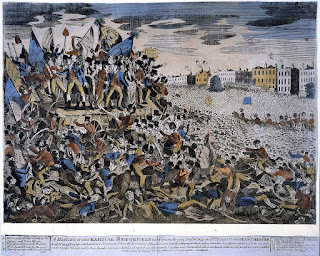On 16 August 1819, a huge
crowd of men, women, and children, estimated at between 60,000 and 80,000,
assembled at St. Peter’s Fields near the rapidly growing industrial city of Manchester.
According to historian Joyce Marlow, the meeting is believed to have been
the largest to date in British history. The purpose was peaceful, to
hear speakers promoting a much-needed reform of Parliamentary representation.
At the
time, most men and all women were denied the right to vote or run for Parliament. The legislature and the government
were controlled by a tiny fraction of the population, mostly aristocrats and
their clients. Since the defeat of Napoleon, the masses had suffered from high
unemployment. Food prices had skyrocketed, in part a result of the recently enacted Corn Laws. These acts placed high tariffs on imported grain, in a bid to keep domestic prices up.
Radicals blamed the dire conditions in the country on a
government that represented narrow landed (aristocratic) interests, hence their
call for a reform that would make parliamentary representation more democratic.
A
pro-reform organization, the Manchester Patriotic Union, organized the mass
demonstration at St. Peter’s Fields. For their headline speaker, they chose a popular
radical, Henry Hunt. He had been an outspoken advocate of parliamentary reforms
for years, but he favored tactics of mass persuasion rather than violence. His
Tory enemies mocked his reputation as a speaker, calling him “Orator” Hunt. The name stuck.
The clamour
for reform, added to the unrest in the country, had long alarmed the
authorities. They feared (or claimed to fear) that Britain was headed for a
revolution similar to that in France in 1789. Hunt's popularity added to
their concern.
On the day
of the Manchester meeting, the local militia and regular soldiers were out in
force. Hundreds of heavily armed cavalry and infantrymen surrounded the meeting
place. Contemporary
accounts claim that the crowd was well behaved, and included families dressed
in their Sunday clothes.
As Hunt got up on the platform to speak, the crowd erupted with a huge
roar of approval. The head of the local magistrates issued a warrant for Hunt’s
arrest.
The man charged with serving the warrant requested military assistance.
The upshot was that cavalry charged into the crowd, wielding sabers to clear
the way and disperse the crowd. As they became entangled among the mass, more
cavalry rode into their rescue. Before the melee finished, they had killed
about a dozen people and injured about 700. One of the dead was a two year old boy, Joseph Fildes.
The actions
of the soldiers sparked immense outrage throughout the country, especially in the popular press. In pointed, shameful contrast to the victory at Waterloo, it soon became known as Massacre of Peterloo.
Among other things, it led to the foundation of the radical Manchester Guardian and inspired Percy Bysshe Shelley to write his
oft-quoted poem, The Masque of Anarchy.
Peterloo was the subject of many contemporary prints. The one below was published only a few days after the event and depicts the moment of Hunt's arrest.
Perhaps the most famous image of Peterloo was that produced by George Cruikshank, who later illustrated some of Dickens' writings.
Peterloo
did not have any immediate effect on reform. In fact, the terrified Tory
government quickly passed a series of acts designed to repress the radical movement, the infamous Six Acts.
The acts were not rigorously enforced, however, and the reform movement continued to
attract popular support in the wake of Peterloo. Fears of popular revolt
grew again after another French Revolution deposed King Charles X in 1830, but on this occasion the British government conceded some of the popular demands.
In 1832 a Whig dominated Parliament
passed the Great Reform Act. Ironically, the ministry that drew it up it was the
most aristocratic in British history. (The Prime Minister, Earl Grey, later had
a bergamot flavored tea named after him.)
Far from
democratic, the Great Reform Bill did extend representation to many new voters,
mostly from the middle class. It also eliminated many corrupt electoral practices. It was
followed by other reform bills in the late 19th and early 20th
centuries that gradually extended political rights to all men and then women. In that sense, Peterloo was stage on Britain's evolution into a democracy.
Further reading: Joyce Marlow, The Peterloo Massacre, 1969.










